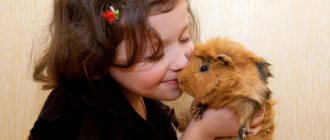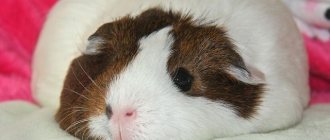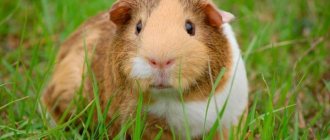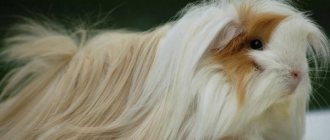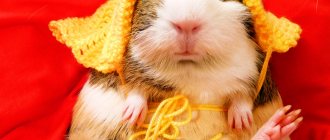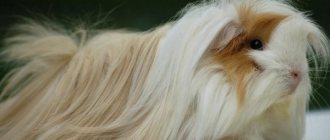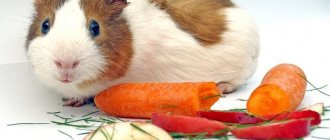The guinea pig is a typical representative of the rodent order. However, it differs in many ways from many of its counterparts. Pigs are smart, they know their owner, they can even be trained. In a word, this is an almost ideal pet. However, pigs have some specific anatomical features, and therefore require additional care and attention from the owners.
That is why it is important to find out all its physiological data before buying a guinea pig. Undoubtedly, such knowledge will help the owner to surround the pet with care and attention and provide decent living conditions.
Guinea pig teeth
The rodent has sharp and well-developed incisors, which grow throughout the life of the animal. Sometimes the incisors reach such sizes that they can cause discomfort to the animal and even injure the tongue or lips. The pig has no fangs, and the molars have characteristic folds and tubercles.
The lower jaw is equipped with only ten teeth:
- 2 false roots,
- 6 indigenous
- 2 incisors.
The lower jaw is characterized by high mobility, which is expressed in the ability to move in different directions (and not just forward and backward). On the upper jaw there are:
- 2 false roots;
- 6 indigenous;
- 2 incisors.
Moreover, the incisors are shorter than those on the lower jaw. The front teeth have very strong enamel, but on the back teeth it is soft and therefore wears off quickly.
Number of toes and nail care
The animal is distinguished by short legs, with the front legs being smaller than the hind legs. There are 4 toes on the hind paws and 3 on the front paws. To many owners, they resemble hooves.
Animal claws require special care. The fact is that they grow incredibly quickly and need periodic trimming. Long claws make it difficult for the animal to walk, and in some cases cause deformation of the feet. For the nail trimming process, you can use nail scissors or a scratching post, which can be easily found in a pet store. With weak pigmentation of the claws, in some cases the vessels of the circulatory system are visible. In this case, it is necessary to trim the claws, avoiding contact of the scissors with the blood vessels. With black or brown claws the task becomes more complicated. You need to cut it in such a way that the overgrown part of the claw is beveled inward. If blood is noticed after the procedure, the wound must be disinfected using standard methods.
Skeleton
The guinea pig skeleton consists of 258 bones:
- tail – 7 pcs.;
- ribs – 13 pairs;
- vertebrates – 34;
- scull;
- rib cage;
- hind legs - 72.
However, a large number of bones does not mean their strength. The fragile bones of the animal’s limbs are especially prone to damage and fractures. Every owner should remember this.
Taste perception
If the mammal is not able to identify the offered food by color or smell, then it tastes a piece of the treat. Guinea pigs have a very good memory and a highly developed instinct, which helps them recognize edible and inedible, tasty and not tasty objects. When it comes to food, guinea pigs are individualists. What one may like may not always be to the taste of another. However, most prefer sweet and juicy foods and rarely eat salty or spicy foods.
Basic rodent systems and their features
The hematopoietic and blood supply system is exactly the same as that of other rodents. The heart weighs about 2 grams. and beats at a frequency of 350 beats per minute.
The respiratory system is distinguished by excessive sensitivity to bacteria and infections of various kinds; animals often suffer from respiratory diseases.
The digestive system is well developed, the stomach reaches a volume of 30 cm, the intestines are extended and have a size 12 times the length of the body. It is for this reason that pigs take a very long time to digest food, about a week.
An interesting feature of the pig’s body structure is the fecal pocket located below, under the anus. The glands of the fecal pouch produce a specific thick secretion. This is another important point in caring for a guinea pig - the pocket needs to be cleaned periodically.
The owner should pay special attention to the health of the lymph nodes located near the ears on the neck. Unusual or too lethargic behavior, poor appetite - a reason to consult a veterinarian. Inflammation of the lymph nodes can lead to an abscess, which is very rare in pigs.
Taste buds
First, the animal tries to identify food by smell. If this cannot be done, then they taste it.
Thanks to the development of intelligence and memory, as well as good taste, they are quite able to distinguish edible from inedible.
Also, pigs often determine high-quality products from low-quality ones. Pigs have developed an individual taste and diet, as well as favorite dishes, which should be selected for each animal personally. But most people prefer succulent and sweet food options.
Peculiarities of vision, hearing and smell of a guinea pig
Cute fluffies have a remarkable ability to observe the entire space around them. This is achieved thanks to the lateral position of the eyes. However, this feature leads to certain problems: the frontal vision of pigs is weakened.
Since pigs are nearsighted, nature compensated by giving them a powerful sense of smell. This is the main landmark in the life of a rodent. The power of smell is hundreds, or even thousands of times stronger than that of humans. Thanks to such a powerful tool, males determine the possibility of females to mate; they are able to sense odors that humans are not even aware of.
The animal navigates the area using tactile hairs on its face. Even in pitch darkness, the animal is able to assess the size of the hole and the ability to penetrate it.
The guinea pig compares favorably with mice and rats in its sensitive hearing. The bulk of mammals have a standard ear structure, where the inner cochlea consists of 2.5 turns. But a guinea pig has 4 such turns. This allows the pig to perceive sound in the range of up to 3000 Hz, while a person hears only 1500 Hz.
Ear structure
As mentioned above, thanks to improved hearing aids, pigs are more receptive to sounds. Unlike humans, who can distinguish 15,000 Hz, pigs pick up waves of twice the frequency. According to research, pigs can also recognize waves that are inaccessible to humans and a number of instruments. For example, they may hear a bang in another room.
The animals have nothing to do with the sea or pigs. According to one version, the animal received its name because of the special structure of its head. In addition to the special structure described earlier and resembling a pig on an enlarged scale, they lack a tail. If the pig is calm, then its voice resembles vibrations of water, and when frightened the animal starts to squeal. The squeal sometimes resembles a grunt, therefore, according to the second theory, pigs got their name because of this similarity.
General physiological data of a rodent
Let's now talk about the basic physiological parameters of rodents. A standard pig lives for 8 years, weighs about two kg, and grows up to 30 cm in length. Among these cute rodents there are also long-livers, some animals live up to 10 years. The body temperature of an adult pig is 39 °C. Sexual maturity occurs in females at 40 days, in males at 60. After a 70-day pregnancy, each female brings a litter of up to 5 cubs.
The anatomy of a guinea pig differs in other ways. For example, the excretory system of a guinea pig is well developed and the animal produces about 55–60 ml of urine per day.
Guinea pigs are gentle and sensitive animals, they are afraid of drafts and dampness. It is important to take this fact into account when creating decent living conditions for your pet.
If there are any signs of illness: decreased motor activity, prolonged silence, which is uncharacteristic of a healthy animal, you need to observe the animal. If the animal is trembling, the fur is disheveled, breathing is rapid, and possibly loose stools - you should immediately consult a veterinarian.
Nuances of the digestive system
It is worth remembering that animals have weak intestines. This is why animals chew their food thoroughly. The stomach consists of 1 chamber and fairly thin walls. Food usually enters the intestines within 5 hours. The type of animal’s intestines is “fillable”, that is, food moves through it as new food arrives. Therefore, long-term fasting is contraindicated for animals. Lack of food often becomes the cause of gastrointestinal problems and even death.
Interesting fact. The complete process of digesting one meal in an animal often takes up to 5–7 days. And the total length of the animal’s intestinal tract exceeds the body size by more than 2-3 times.
Do I need to give my animal extra vitamins?
Veterinarians often recommend giving guinea pigs vitamin C by adding it to the water bowl at the rate of 1 mg per 1 ml of water. However, in the light this vitamin quickly loses its properties, so the solution must be changed at least once a day.
flickr/pyza*
The animal must receive the rest of the vitamins through food. It is curious that vitamins B and K are absorbed only the second time, so rodents sometimes eat their own droppings.
Reproduction and raising of young
Sexual maturity in wild guinea pigs occurs quickly. Males reach reproductive age at 2-3 months, and females are ready for procreation after 1 month of life. But the body of these rodents is fully formed before six months, so they mate no earlier than they are 5-6 months old.
Cavias can reproduce throughout the year, but often mate only in the warm season, when there is enough food around, which creates more favorable conditions for raising young animals.
In a clan of wild guinea pigs there is only one dominant male, and they do not have such concepts as mating games and battles for a female. The leader of the pack covers all his furry “wives”, who signal their readiness to become a mother in heat, leaving odorous marks for the male.
The baby will learn from his mother's experience of surviving in the wild
The general gestation period for guinea pigs is 2-2.5 months, and in one year females can give birth 3-4 times. There are from 1 to 8 cubs in one litter, their number depends on the age of the expectant mother. Young females give birth to 2-3 babies; the brood of more mature females can have from 4 to 8 offspring.
Newborn pigs are born well developed. Their eyes and ear canals are open, they have molars, and their entire body is covered with soft fur. The cubs grow very quickly, and already on the 3rd day of life they try juicy green grass for the first time, although they continue to feed on their mother’s milk for the next week.
Young pigs have only 4 weeks to learn how to get their own food, recognize the signals of their relatives, and distinguish the sounds and smells made by predators. Upon reaching 1 month, the cubs must leave their native clan and begin an independent life. Young cavys have to find their own territory and form a new family, and it is at this stage that most of the pigs die in the clutches of predatory animals.
Interesting facts about the anatomy of the animal
The animal's heart weighs no more than two and a half grams, and the frequency of contractions of the heart muscle is up to 350 per minute. A guinea pig takes approximately one hundred to one hundred twenty breaths per minute. The animal's lungs are very susceptible to various viruses and bacteria, and the most common diseases are respiratory in nature. The excretory system of the guinea pig is well developed and the animal produces about 55 - 60 ml of urine per day. The anatomy of a guinea pig has other features.
Males and females have a caudal gland. In males it is more pronounced; in females it can sometimes be completely absent. The gland is located a centimeter above the anus. The main function is the release of odorous aromatic substances.
The second feature is the fecal pocket. It is located under the anus. In the male's fecal pouch there are glands that are responsible for secreting a thick and odorous liquid. The fecal pocket should be cleaned regularly, as particles of feces, hairs, shavings or sawdust, and hay can accumulate in it. The third feature is one pair of mammary glands (mice have five pairs, rats have six pairs, and rabbits have four pairs). The animal's lungs are also different. The left lung is divided into three parts, and the right lung into four. The right lung is also heavier than the left.
Source




